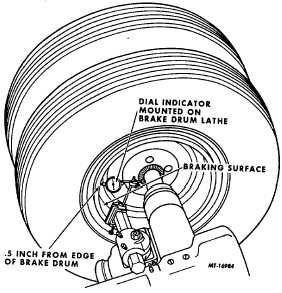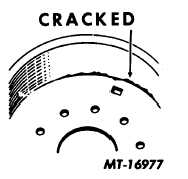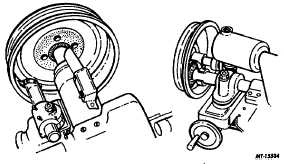|
| |
TRUCK SERVICE MANUAL
TM 5-4210-230-14&P-1
WHEELS, RIMS, TIRES
Fig. 4
emery or steel wool particles from drum after this operation.
More heavily damaged or out-of-round drums should be
ground or turned on brake drum lathe.
If depth of scoring, bellmouth or barrel shaping exceeds
.13 mm (.005"), measured with micrometer across part or all
of brake surface, drum should be refinished. Reboring limits
(see drum) must not be exceeded and no heat checks, cracks
or bluing is evident.
Use a micrometer also to check for an out-of-round
drum. Make check by measuring drum brake surface
diameter at various points, 45° apart around circumference.
Eccentricity (out-of-round) should not exceed .38 mm (.015")
on diameter.
For older brake drums which do not show a maximum
diameter the drum must be discarded when diameter is
3.05mm (.120") over original diameter.
Remember that each time brake drums are turned, less
metal remains to absorb the heat developed by braking
action. Brake drums containing less metal will operate at a
higher temperature. As a result, brake fade, slow recovery
and erratic wear will be more noticeable. Also, extremely high
temperatures shorten lining life and cause heat checks and
cracks (Fig. 5) form on inner surface of drums. These
conditions will become progressively worse until finally drums
fail.
Fig. 5
To recondition a brake drum in a lathe (Fig. 6), the
drum must be mounted so that it is centered. Use proper size
cone to provide accurate centering. Turn drum, taking only
light cuts and remove just enough material to clean up drum.
Then grind the finished surface if grinder is available or use
emery cloth on a straight piece of wood and polish the drum
friction surface.
NOTE: Brake drums that are otherwise in
good condition can be turned in a lathe.
However,
it
must
be
remembered
that
recommended rebore limit for brake drums
over 35.6 cm (14") in diameter must not be
increased
more
than
2.03
mm
(.080")
diameter (total cut) and discarded at 3.05 mm
(.120") over normal diameter.
Brake drums should be cleaned thoroughly with a
steam cleaner or hot water. Do not use a solvent which leaves
an oily residue. If inspection shows the drums may be used
without remachining, rub friction surface with fine emery cloth
or sandpaper to remove any foreign deposits. If drum has
been reconditioned, clean friction surface with fine emery
cloth or sandpaper and wash. Next examine very carefully to
see that no metal chips remain in drum.
Fig. 6
CTS-2032N Page 2
PRINTED IN UNITED STATES OF AMERICA
|



